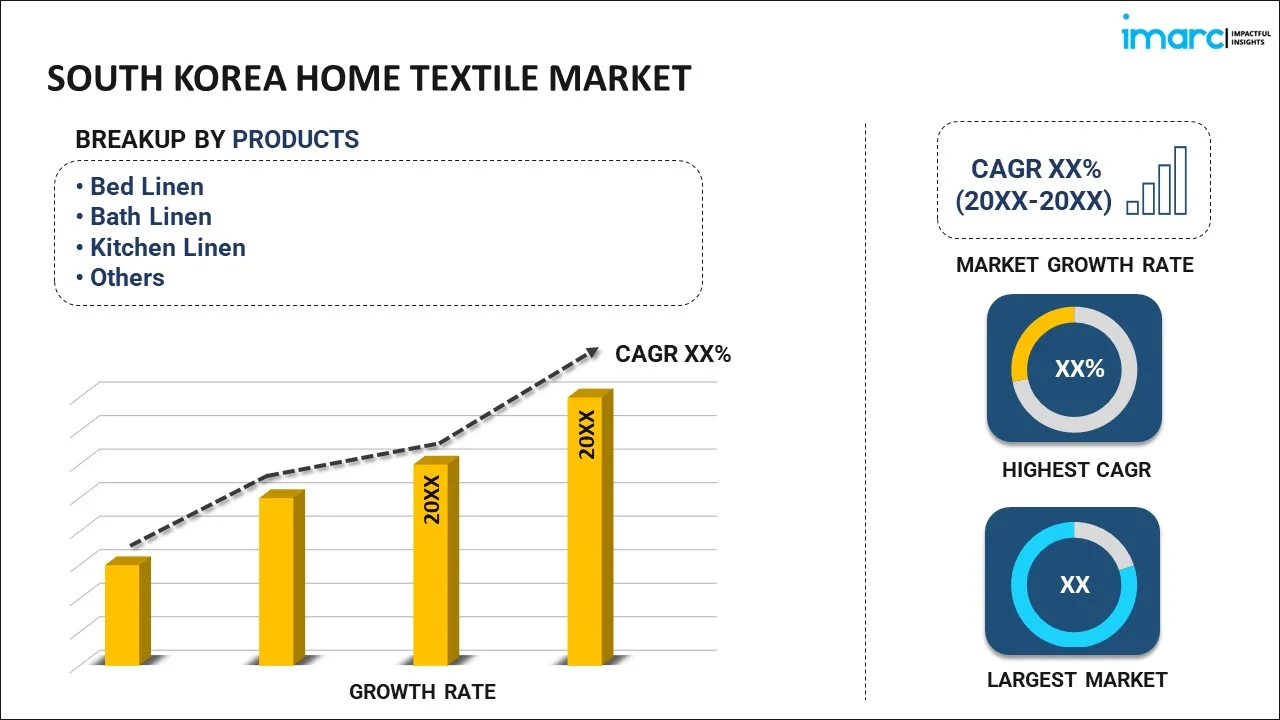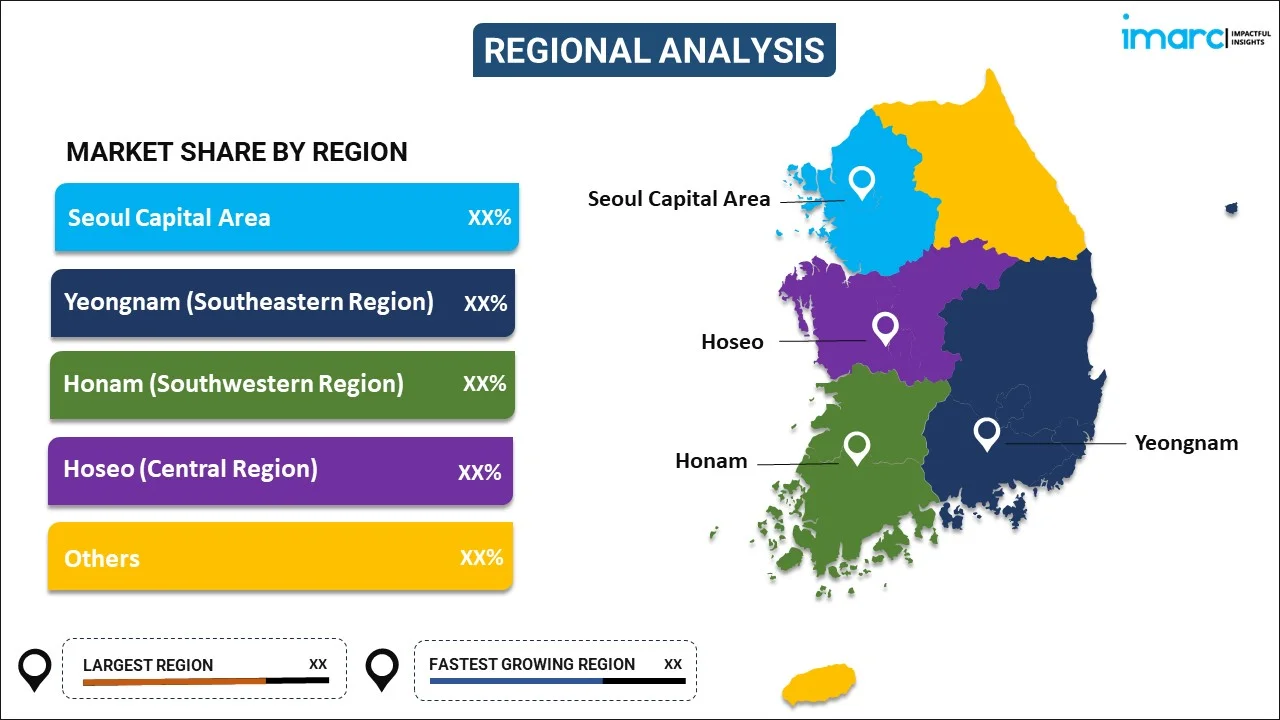
South Korea Home Textile Market Report by Product (Bed Linen, Bath Linen, Kitchen Linen, Upholstery Covering, Floor Covering), Distribution Channel (Supermarkets and Hypermarkets, Specialty Stores, Online, and Others), End User (Residential, Commercial), and Region 2025-2033
Market Overview:
South Korea home textile market size reached USD 2.5 Billion in 2024. Looking forward, IMARC Group expects the market to reach USD 3.9 Billion by 2033, exhibiting a growth rate (CAGR) of 5.1% during 2025-2033. The growing awareness about sustainability among the masses, continual advancements in textile technology leading to the production of smart home textiles, inflating disposable income levels, and the proliferation of e-commerce platforms and expansion of digital channels represent some of the key factors driving the market.
|
Report Attribute
|
Key Statistics
|
|---|---|
|
Base Year
|
2024 |
|
Forecast Years
|
2025-2033
|
|
Historical Years
|
2019-2024
|
| Market Size in 2024 | USD 2.5 Billion |
| Market Forecast in 2033 | USD 3.9 Billion |
| Market Growth Rate (2025-2033) | 5.1% |
Home textiles refer to the range of textile products used as household items. These are designed primarily for utility and aesthetic purposes to enhance the quality of domestic living. They include a wide variety of items such as curtains, bed linens, cushions, towels, tablecloths, and carpets. The textiles serve several functional roles, such as providing comfort, adding to the interior decor, and sometimes offering specific benefits, such as water repellency, fire resistance, or antibacterial properties. They come in different materials, including but not limited to cotton, silk, polyester, and wool. In addition to their functional roles, home textiles can also be highly decorative, featuring intricate designs, embellishments, and a range of colors to complement the overall interior design of a home. The textiles can be designed to fit into various styles, such as traditional, contemporary, or modern themes. Their importance extends beyond the household into commercial settings, such as hotels, hospitals, and offices, where they serve similar functions.
South Korea Home Textile Market Trends:
The inflating disposable income levels of the masses, who are investing more in home improvement and décor is a major factor that is driving the market in South Korea. These demographic shifts make quality home textiles, including curtains, cushions, and bed linens, more accessible and desirable. As individuals opt for high-end, comfortable, and aesthetically pleasing home environments, the demand for premium home textile products is rising. The growing awareness around sustainability is contributing to the growth of the market. Eco-friendly and organic textiles are becoming increasingly popular, driven by consumer demand for responsible and sustainable production methods. This has encouraged manufacturers to adopt environmentally friendly practices, using organic fibers and dyes and promoting recycled and sustainable products. Apart from this, continual advancements in textile technology have led to the production of smart home textiles with enhanced functionalities, such as temperature regulation, moisture-wicking, and even antibacterial properties. These innovations add value to the products and provide manufacturers with a unique selling point to differentiate in a competitive market. Besides this, South Korea's export-oriented economy and strong manufacturing capabilities, free trade agreements and strategic partnerships are stimulating the market. Also, South Korean pop culture has significantly increased the country's soft power and is therefore creating a positive outlook for the market. Furthermore, the growing popularity of Korean designs, influenced by cultural elements and modern aesthetics, gives the country's products a unique positioning, both domestically and internationally. Also, the proliferation of e-commerce platforms and digital channels is acting as another growth-inducing factor. Furthermore, online shopping has made it easier for consumers to access a wider range of home textile products, which is beneficial for both local and international brands seeking to expand their reach.
South Korea Home Textile Market Segmentation:
IMARC Group provides an analysis of the key trends in each segment of the market, along with forecasts at the country level for 2025-2033. Our report has categorized the market based on product, distribution channel, and end user.
Product Insights:

- Bed Linen
- Bath Linen
- Kitchen Linen
- Upholstery Covering
- Floor Covering
The report has provided a detailed breakup and analysis of the market based on the product. This includes bed linen, bath linen, kitchen linen, upholstery covering, and floor covering.
Distribution Channel Insights:
- Supermarkets and Hypermarkets
- Specialty Stores
- Online
- Others
A detailed breakup and analysis of the market based on the distribution channel have also been provided in the report. This includes supermarkets and hypermarkets, specialty stores, online, and others.
End User Insights:
- Residential
- Commercial
- Hospitality and Leisure
- Hospital
- Offices
- Others
The report has provided a detailed breakup and analysis of the market based on the end user. This includes residential and commercial (hospitality and leisure, hospital, offices, and others).
Regional Insights:

- Seoul Capital Area
- Yeongnam (Southeastern Region)
- Honam (Southwestern Region)
- Hoseo (Central Region)
- Others
The report has also provided a comprehensive analysis of all the major regional markets, which include Seoul Capital Area, Yeongnam (Southeastern Region), Honam (Southwestern Region), Hoseo (Central Region), and Others.
Competitive Landscape:
The market research report has also provided a comprehensive analysis of the competitive landscape in the market. Competitive analysis such as market structure, key player positioning, top winning strategies, competitive dashboard, and company evaluation quadrant has been covered in the report. Also, detailed profiles of all major companies have been provided.
South Korea Home Textile Market Report Coverage:
| Report Features | Details |
|---|---|
| Base Year of the Analysis | 2024 |
| Historical Period | 2019-2024 |
| Forecast Period | 2025-2033 |
| Units | Billion USD |
| Scope of the Report | Exploration of Historical and Forecast Trends, Industry Catalysts and Challenges, Segment-Wise Historical and Predictive Market Assessment:
|
| Products Covered | Bed Linen, Bath Linen, Kitchen Linen, Upholstery Covering, Floor Covering |
| Distribution Channels Covered | Supermarkets and Hypermarkets, Specialty Stores, Online, Others |
| End Users Covered |
|
| Regions Covered | Seoul Capital Area, Yeongnam (Southeastern Region), Honam (Southwestern Region), Hoseo (Central Region), Others |
| Customization Scope | 10% Free Customization |
| Post-Sale Analyst Support | 10-12 Weeks |
| Delivery Format | PDF and Excel through Email (We can also provide the editable version of the report in PPT/Word format on special request) |
Key Questions Answered in This Report:
- How has the South Korea home textile market performed so far and how will it perform in the coming years?
- What has been the impact of COVID-19 on the South Korea home textile market?
- What is the breakup of the South Korea home textile market on the basis of product?
- What is the breakup of the South Korea home textile market on the basis of distribution channel?
- What is the breakup of the South Korea home textile market on the basis of end user?
- What are the various stages in the value chain of the South Korea home textile market?
- What are the key driving factors and challenges in the South Korea home textile?
- What is the structure of the South Korea home textile market and who are the key players?
- What is the degree of competition in the South Korea home textile market?
Key Benefits for Stakeholders:
- IMARC’s industry report offers a comprehensive quantitative analysis of various market segments, historical and current market trends, market forecasts, and dynamics of the South Korea home textile market from 2019-2033.
- The research report provides the latest information on the market drivers, challenges, and opportunities in the South Korea home textile market.
- Porter's five forces analysis assist stakeholders in assessing the impact of new entrants, competitive rivalry, supplier power, buyer power, and the threat of substitution. It helps stakeholders to analyze the level of competition within the South Korea home textile industry and its attractiveness.
- Competitive landscape allows stakeholders to understand their competitive environment and provides an insight into the current positions of key players in the market.
Need more help?
- Speak to our experienced analysts for insights on the current market scenarios.
- Include additional segments and countries to customize the report as per your requirement.
- Gain an unparalleled competitive advantage in your domain by understanding how to utilize the report and positively impacting your operations and revenue.
- For further assistance, please connect with our analysts.
 Inquire Before Buying
Inquire Before Buying
 Speak to an Analyst
Speak to an Analyst
 Request Brochure
Request Brochure
 Request Customization
Request Customization




.webp)




.webp)












